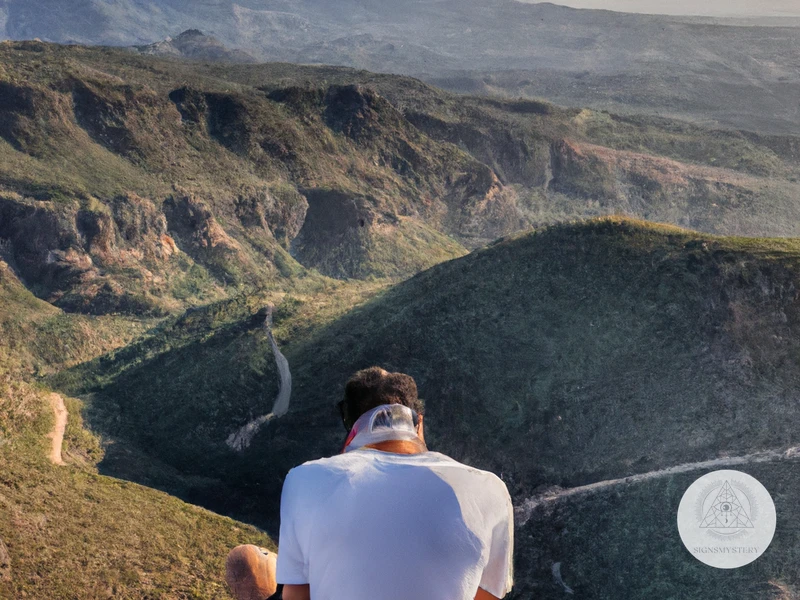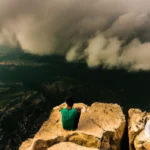Venturing into the unknown and embarking on an inward journey can be both intimidating and intriguing. For those seeking spiritual growth and a deeper understanding of themselves and their place in the world, a Vision Quest may hold great appeal. However, misconceptions about Vision Quests often prevent individuals from taking this transformative journey. In this article, we will debunk common misunderstandings about Vision Quests and provide a step-by-step guide for safe and meaningful participation in this ancient practice. Whether you are a beginner or an experienced seeker, read on to discover the truth behind the myths of Vision Quests.
What is a Vision Quest?

A vision quest is a profound and powerful spiritual journey that has been an integral part of many indigenous cultures for centuries. Traditionally, a vision quest is a rite of passage that involves spending several days and nights alone in nature, often fasting and meditating, in order to connect with the spirit world and gain a deeper understanding of oneself and one’s place in the world. During a vision quest, a person seeks to receive guidance, clarity, and insights from the universe. Vision quests can be a life-changing experience and can lead to personal transformation. If you are interested in learning more about vision quests, check out our article on vision quests in shamanism.
The Definition of a Vision Quest in Shamanism
In shamanism, a vision quest is a traditional Native American practice that involves going into the wilderness to commune with nature and spirit guides for the purpose of gaining insight and guidance. It is a journey of self-discovery, personal growth and spiritual enlightenment.
During a vision quest, participants seek a deep understanding of their purpose in life by connecting with nature and their inner selves. They often fast and meditate or pray for days or weeks, seeking a vision or insight that will guide them on their life’s path.
It is believed that during a vision quest, individuals can receive answers to their deepest questions, receive guidance on important decisions, and gain spiritual wisdom. It is an important practice for those seeking a deeper connection with the spiritual realm and themselves.
| 📍 | To summarize, a vision quest in shamanism is: |
| 1. | A traditional Native American practice |
| 2. | A journey of self-discovery, personal growth and spiritual enlightenment |
| 3. | A practice of connecting with nature and spiritual guides |
| 4. | Involved fasting, meditating or praying for days or weeks |
| 5. | A way of receiving answers, guidance, and spiritual wisdom |
A vision quest is a powerful and transformative experience, but it requires preparation and guidance to achieve the intended results. Participants should know what to expect, how to prepare for the quest, and what to do afterwards. For more information on how to prepare and what to expect, check out our article on preparing for a vision quest.
The Purpose of a Vision Quest
The Purpose of a Vision Quest is to seek a deeper connection with oneself and the world around us. It is a soul-searching journey that can bring clarity, guidance, and personal growth. The primary purpose of a Vision Quest is to receive a vision or guidance from the spirit world. This vision is believed to provide a sense of direction for one’s life, help one understand their purpose and meaning, and even contribute to the greater good.
During a Vision Quest, individuals typically enter a state of fasting, seclusion, and prayer. This is done to allow the ego to quiet down and allow the individual to listen to their inner voice and develop a stronger connection to the spiritual world. The journey is often accompanied by a range of emotions and experiences, from fear and vulnerability to transcendence and awakening.
The Purpose of a Vision Quest can be summarised in the following table:
| Purpose | Explanation |
|---|---|
| Receive a vision | To gain guidance from the spirit world for one’s life purpose |
| Connect with oneself | To gain a deeper understanding of oneself and inner voice |
| Develop a sense of direction | To provide clarity and direction for one’s life path |
| Contribute to the greater good | To gain a sense of interconnectedness and to seek ways of using one’s purpose for the good of all |
A Vision Quest is a sacred practice that has been conducted for centuries. The Purpose of a Vision Quest is to seek guidance, clarity and connection with oneself and the spiritual world. By embarking on this journey, one can gain insight into their life purpose, and it can open up a path of personal growth and contribution to the world. If you wish to learn more about the typical vision quest steps, please refer to our article on /typical-vision-quest-steps/.
History of Vision Quests
The origins of Vision Quests can be traced back to indigenous cultures around the world. Native Americans have long used Vision Quests as a rite of passage for young teens to gain spiritual insight and find their place in the community. In Mesoamerican culture, Vision Quests were used to communicate with the gods and gain knowledge about the future.
Early Christian mystics and ascetics also practiced forms of Vision Quests, known as hermitages or desert retreats. The Irish monk St. Patrick, for example, spent six years on a remote island in the Irish Sea meditating in solitude.
In recent years, Vision Quests have become popular in Western culture, often adapted to fit modern spiritual practices. The term “Vision Quest” was coined by various authors such as anthropologist and author Carlos Castaneda and new age author Steven Foster.
Despite the changes in context, the core purpose of the Vision Quest remains the same – a journey of self-discovery and spiritual growth through connection with nature and the divine.
| Indigenous Culture | Type of Vision Quest |
|---|---|
| Native American | Solo Fast, Sweat Lodge |
| Australian Aboriginal | Walkabout, Dreamtime |
| Mesoamerican | Temazcal, Peyote Ceremony |
The ceremonies and practices of Vision Quests vary greatly depending on the culture and tradition. For example, in Native American tradition, fasting and isolation in nature are often key components, while Mesoamerican Vision Quests often involve the use of psychoactive substances like peyote.
Despite their differences, all Vision Quests share the goal of connecting with the spiritual and natural worlds, gaining insight, and finding one’s place in the universe.
Want to learn more about animal spirit guides and their meanings in Vision Quests? Check out our guide on Animal Spirit Guides Meanings in Vision Quests.
Common Misconceptions about Vision Quests
There are several common misconceptions about vision quests that people often have. Firstly, many people believe that vision quests are dangerous, but this is not necessarily true. While there are risks involved, such as exposure to the elements and dehydration, these risks can be mitigated with proper preparation and guidance. Secondly, there is a belief that only experienced practitioners can undertake a vision quest. However, with the support and guidance of a skilled practitioner, anyone can participate in a vision quest. Thirdly, some may associate vision quests with the use of hallucinogenic plants, but this is not a requirement to have a vision quest experience. Fourthly, there is a belief that vision quests are a shortcut to enlightenment, but in reality, they require hard work and dedication to achieve spiritual growth. Finally, some believe that vision quests are a one-time experience, but multiple quests can be done throughout one’s lifetime. It is important to distinguish between fact and fiction when it comes to vision quests.
Vision Quests are Dangerous
There is a common misconception that Vision Quests are inherently dangerous, and that participants may experience physical or mental harm during the process. However, while there are certainly risks associated with any form of personal growth or spiritual practice, Vision Quests themselves can be conducted safely when done with proper preparation and guidance.
It is important to note that Vision Quests should never be attempted alone or without the guidance of a trained and experienced shaman or spiritual leader. These individuals can provide critical support and guidance throughout the process, helping participants to navigate any challenges or difficulties that may arise.
Additionally, it is important to take appropriate safety precautions when choosing a location for the Vision Quest. This may include selecting a site that is free from hazards such as poisonous plants or steep drops, as well as ensuring that appropriate shelter and supplies are available for the duration of the Quest.
Ultimately, the safety of a Vision Quest depends largely on the preparation and experience of the participants and the guidance of the shaman or spiritual leader. While there are certainly risks involved, these can be mitigated through careful planning and preparation.
Here are some key steps that can help ensure a safe and successful Vision Quest:
| Step | Description |
| 1. | Choose a qualified shaman or spiritual leader who can guide you through the process. |
| 2. | Select an appropriate location for the Vision Quest, free from hazards such as poisonous plants or steep drops. |
| 3. | Prepare appropriately, both physically and mentally, for the challenges of the Vision Quest. |
| 4. | Ensure that appropriate shelter and supplies are available for the duration of the Quest. |
| 5. | Stay in communication with your shaman or spiritual leader throughout the process, and heed their guidance as needed. |
By taking these steps and approaching the Vision Quest with the appropriate level of respect and preparation, participants can safely and effectively explore deeper aspects of themselves and the world around them.
For more information on the different types of Vision Quests, click here. And for tips on what to do after a Vision Quest, click here.
Vision Quests are only for Experienced Practitioners
One common misconception about vision quests is that they are only for experienced practitioners. This notion creates a barrier for newcomers who may be interested in embarking on a vision quest but feel that they lack the necessary experience.
However, this is not entirely true. While it may be helpful to have some experience with meditation or other spiritual practices, it is not a requirement for a vision quest. What is more important is having a strong intention and the willingness to learn and trust in the process.
It is also worth noting that there are many different types of vision quests, each with their own level of intensity and requirements. For example, some vision quests may involve fasting and solitude for multiple days, while others may be less intense and involve shorter periods of time in nature.
To further debunk this misconception, let’s look at some reasons why vision quests can be accessible to anyone, regardless of their level of experience:
| Reason | Explanation |
| Guidance | Experienced practitioners, such as shamanic guides or teachers, can offer guidance and support to those who are new to vision quests. |
| Preparation | Proper preparation, such as physical and mental conditioning, can help ensure a successful vision quest regardless of the practitioner’s level of experience. |
| Intentions | Having clear intentions and a willingness to surrender to the process can be more important than experience when it comes to vision quests. |
While experience can certainly be helpful, it is not a requirement for embarking on a vision quest. With the proper guidance, preparation, and intentions, anyone can have a meaningful and transformative vision quest experience.
Vision Quests involve Hallucinogenic Plants
One common misconception about vision quests is that they always involve the use of hallucinogenic plants. However, this is not entirely true. While some traditional cultures may use plants like ayahuasca or peyote in their vision quests, there are many other ways to connect with the spiritual realm without the use of such plants.
It’s important to note that the use of hallucinogenic plants in a vision quest should only be done under the guidance of an experienced practitioner. Improper use of these plants can be dangerous and even life-threatening.
In fact, many modern practitioners of vision quests choose to refrain from using hallucinogens altogether. Instead, they may rely on traditional methods such as fasting, meditation, or spending time alone in nature.
The goal of a vision quest is not to have a psychedelic experience, but rather to connect with one’s inner self and gain insight and wisdom. This can be achieved through different means, depending on the individual’s beliefs and preferences.
It’s important to do thorough research and seek guidance from a qualified practitioner before embarking on any type of vision quest, whether it involves hallucinogenic plants or not. This will ensure a safe and meaningful experience.
Vision Quests are a Shortcut to Enlightenment
One common misconception about vision quests is that they are a shortcut to enlightenment. This misconception may stem from the fact that some people have reported profound spiritual experiences during a vision quest, leading them to believe that they have reached a higher state of being.
However, it is important to note that a vision quest is not a one-time, instantaneous experience that leads to automatic enlightenment. Rather, it is a process of self-discovery and spiritual growth that requires ongoing dedication and effort.
There is no easy or quick path to enlightenment, and anyone who claims to have found a shortcut should be viewed with skepticism. True enlightenment requires hard work, self-awareness, and a deep understanding of oneself and the world around us.
Even experienced practitioners of vision quests do not claim to have achieved enlightenment. The purpose of a vision quest is to gain insight and clarity, not to become a fully enlightened being overnight.
It is important to approach vision quests with the understanding that they are a tool for personal growth and spiritual development. While it is possible to have profound experiences during a vision quest, it is not a guaranteed path to enlightenment.
The idea that vision quests are a shortcut to enlightenment is a misguided notion. Rather, vision quests are a means to gain insight, clarity, and personal growth through a process of self-discovery and dedication. Shortcut to enlightenment is a misleading idea that can lead individuals astray in their spiritual journey.
Vision Quests are a One-Time-Deal
Many people believe that a vision quest is a one-time deal and that if you don’t have a clear vision or experience spiritual enlightenment the first time, then you have failed. This is a common misconception about vision quests. The truth is that a vision quest can be done multiple times throughout one’s lifetime.
Vision Quests and Personal Growth: Many people use vision quests as a tool for personal growth and self-discovery. It’s not uncommon for individuals to do multiple vision quests over the course of their lifetime. Each experience can bring new insights and understanding that can aid in personal growth.
Vision Quests and Life Transitions: Vision quests are often used to mark significant life transitions such as the end of a relationship, the loss of a loved one, or the start of a new chapter. It’s not uncommon for individuals to do multiple vision quests throughout their life to process and reflect on these significant events.
Vision Quests as a Tool for Reflection: Vision quests can be used as a tool for reflection and meditation. It can be a way to take a step back from the chaos of daily life and reflect on one’s thoughts, emotions, and experiences. This can be done multiple times throughout one’s lifetime to aid in personal reflection and growth.
Vision quests are not a one-time deal. They can be done multiple times throughout one’s lifetime and can serve as a tool for personal growth, reflection, and marking significant life transitions. It’s important to approach each vision quest with an open mind and heart and not place too much pressure on having a specific outcome or vision.
Debunking Misconceptions about Vision Quests
There are several common misconceptions about Vision Quests that tend to scare people away or make them hesitant to try this solitary spiritual practice. However, these misconceptions are based on myths and false information. So, let’s debunk these misconceptions and learn the truth about Vision Quests. First, Vision Quests can be safe when done properly, meaning that participants must be physically and mentally fit, have
Subscribe to Our Newsletter
Sign up to receive the latest news and updates.
Vision Quests can be Safe when Done Properly
When done properly, vision quests can be a safe and rewarding experience. Here are some steps to ensure safety during a vision quest:
| Step 1: | Choose a reputable guide or organization that has experience leading vision quests. Make sure they have adequate safety protocols in place, such as a system for checking in on participants during the quest. |
| Step 2: | Prepare physically and mentally for the quest. This may include fasting, drinking plenty of water, and practicing meditation or other mindfulness techniques. |
| Step 3: | Choose an appropriate location for the quest, taking into account factors such as terrain, weather conditions, and wildlife. Make sure you have permission to be on the land and respect any guidelines or restrictions in place. |
| Step 4: | Set intentions and clear expectations for the quest. This may involve creating a ceremony or ritual, and communicating with your guide or fellow participants about your goals and boundaries. |
| Step 5: | During the quest, stay hydrated and take care of your physical needs, such as using sunscreen or bug repellent. Listen to your body and rest as needed. |
| Step 6: | After the quest, take time to integrate the experience and reflect on any insights or revelations. Seek support from your guide or community as needed. |
It’s also important to remember that while vision quests can be safe, there are always risks involved in any intense spiritual or personal growth experience. It’s crucial to approach a vision quest with respect, humility, and awareness of your own limitations. With the proper preparation and guidance, a vision quest can unlock deep wisdom and transformation.
Vision Quests can be Done by Anyone with Guidance
It is a common misconception that Vision Quests can only be done by experienced practitioners. However, with proper guidance, Vision Quests can be done by anyone who feels called to embark on this spiritual journey.
The guidance of a skilled shaman, who has undergone their own Vision Quests and is well-versed in the process, is highly recommended. They can provide support, answer questions, and offer insights and interpretations of any visions or experiences that may arise during the quest.
Additionally, preparation is key in successfully completing a Vision Quest. This includes physical preparation such as fasting and purification practices, as well as mental and emotional preparation. The guidance of a shaman can help navigate these preparations and ensure the safety and well-being of the quester.
It is important to note that Vision Quests are not meant to be taken lightly and should not be attempted without proper guidance and preparation. However, with the right support and readiness, anyone can embark on a Vision Quest and access the transformative power and insights it can offer. As the saying goes, “when the student is ready, the teacher will appear.” The guidance of a skilled shaman can be the teacher that helps the student journey into the depths of their own consciousness through a Vision Quest.
Vision Quests Don’t Require Hallucinogenic Plants
One of the most common misconceptions about vision quests is that they require the use of hallucinogenic plants. While some individuals may choose to incorporate the use of these plants into their vision quest, they are by no means a requirement for the practice.
There are many traditional vision quest ceremonies that do not involve the use of any substances at all. Many indigenous cultures use fasting, meditation, and prayer to induce a state of altered consciousness and connect with the spiritual realm. These methods allow the individual to tap into their own inner wisdom without the use of any external substances.
Additionally, while some modern vision quests may make use of plants such as ayahuasca or peyote, it is important to note that the use of these substances can be dangerous if not properly administered. It is always advised to seek out a trained and experienced practitioner if you are considering incorporating the use of these plants into your vision quest.
The truth is, the power of a vision quest lies not in any external substance, but rather in the intention and dedication of the individual undertaking the practice. By committing to the process, setting clear intentions, and trusting in the wisdom of the universe, one can achieve profound spiritual insights and personal growth without the use of any plant medicine.
So, if the idea of consuming hallucinogenic plants doesn’t appeal to you, rest assured that it is not a requirement for the practice of vision quests. There are many other methods that can be utilized to achieve the same powerful results.
Vision Quests aren’t a Shortcut to Enlightenment
It is a common misconception that a vision quest is a shortcut to enlightenment. This simply is not the case. A vision quest is not a magical practice that will instantly lead to enlightenment. The purpose of a vision quest is to provide an individual with an opportunity to gain a deeper understanding of oneself, one’s purpose, and the world. It is a journey that involves introspection, self-reflection, and hard work.
Many people believe that by going on a vision quest and having a vision, they will be instantly enlightened. However, this is not the case. A vision is only a glimpse into the deeper understanding that one can attain through a quest. The true work begins after the vision quest is completed. It is only through continued self-reflection and dedication that one can truly achieve enlightenment and a deeper understanding of oneself and the world around them.
It is important to note that enlightenment is not a destination that can be reached. It is an ongoing journey that one must continually work towards. A vision quest can be a powerful tool in aiding this journey, but it is not a shortcut. In fact, taking shortcuts can diminish the true value and meaning of a vision quest.
A vision quest is not a shortcut to enlightenment. It is a journey that requires dedication, hard work, and self-reflection. The true value of a vision quest is in the ongoing journey of self-discovery and understanding, not the attainment of a single vision.
Multiple Vision Quests can be Done in a Lifetime
It is commonly believed that a vision quest can only be done once in a lifetime. However, this is a misconception as multiple vision quests can be done in a lifetime. In fact, doing multiple vision quests can help individuals deepen their connection with their spirituality and gain further insights into their lives.
Each vision quest is unique and can offer different guidance and teachings. The first vision quest might provide an overall direction, while the second one may offer more specific guidance. It is important to note that each vision quest is a step in a journey, rather than a destination.
However, it is important to approach each vision quest with the same respect and preparation as the first. Proper preparation is essential to ensure the safety and effectiveness of the vision quest. It is recommended to work with experienced practitioners who can guide and support individuals through the process.
The decision to undertake multiple vision quests ultimately depends on the individual and their spiritual journey. Some individuals may find that one vision quest is enough, while others may feel called to do multiple quests throughout their lifetime. The number of vision quests an individual undertakes is not a measure of their spiritual growth, but rather a personal choice based on their own journey and connection with their spirituality.
Multiple vision quests can be done in a lifetime, and each one can offer unique teachings and guidance. However, it is important to approach each vision quest with proper preparation and guidance from experienced practitioners. The decision to undertake multiple quests ultimately depends on the individual and their spiritual journey, and the number of quests is not a measure of their spiritual growth.
Conclusion
In conclusion, misconceptions about vision quests are widespread, but they can be debunked by understanding the true nature of this spiritual practice. Vision quests are not necessarily dangerous if they are done properly with adequate preparation and guidance from experienced practitioners. They are not reserved solely for experienced practitioners, and anyone can embark on a vision quest with the right mindset and guidance.
Moreover, the use of hallucinogenic plants is not a requirement for vision quests, and shortcuts to enlightenment do not exist. Vision quests offer a unique opportunity for individuals to connect with the natural world and gain a deeper understanding of themselves and their place in the world.
While it is true that vision quests are typically a one-time experience, it is possible for individuals to embark on multiple quests throughout their lifetime. These experiences are not only transformative but also provide a sense of renewed purpose and direction.
Ultimately, vision quests are a deeply personal and spiritual practice that can offer profound insights and revelations to those who embark on them. By dispelling common misconceptions, more people can be encouraged to explore this ancient practice and connect with their inner selves.
Frequently Asked Questions
Can anyone go on a vision quest?
Yes, anyone can go on a vision quest as long as they have guidance and preparation beforehand.
Do vision quests always involve hallucinogenic plants?
No, vision quests do not always involve hallucinogenic plants. There are alternative methods to achieve a vision quest.
Is a vision quest dangerous?
A vision quest can be dangerous if proper preparation and guidance are not followed. However, with these in place, it can be a safe experience.
Can you achieve enlightenment through a vision quest?
A vision quest can provide insights and spiritual growth, but it is not a guaranteed shortcut to enlightenment.
How long does a vision quest typically last?
A vision quest can last anywhere from a few days to several weeks, depending on the practitioner’s tradition and practices.
Do you have to fast during a vision quest?
Fasting is a common practice during a vision quest, but it is not always required. It depends on the practitioner’s tradition and beliefs.
Can a vision quest be done alone?
Some traditions allow for an individual vision quest, but it is recommended to have guidance and support from experienced practitioners.
Can vision quests be done in groups?
Yes, vision quests can be done in groups to provide support and community during the experience.
Can a vision quest be done in a modern urban setting?
Yes, there are modern adaptations of vision quests that can be done in urban settings. It is important to find a qualified guide or community to facilitate the experience properly.
Do vision quests have to be in a wilderness setting?
A wilderness setting is common for traditional vision quests, but it is not always required. Alternative settings can be used depending on the practitioner’s beliefs and traditions.










